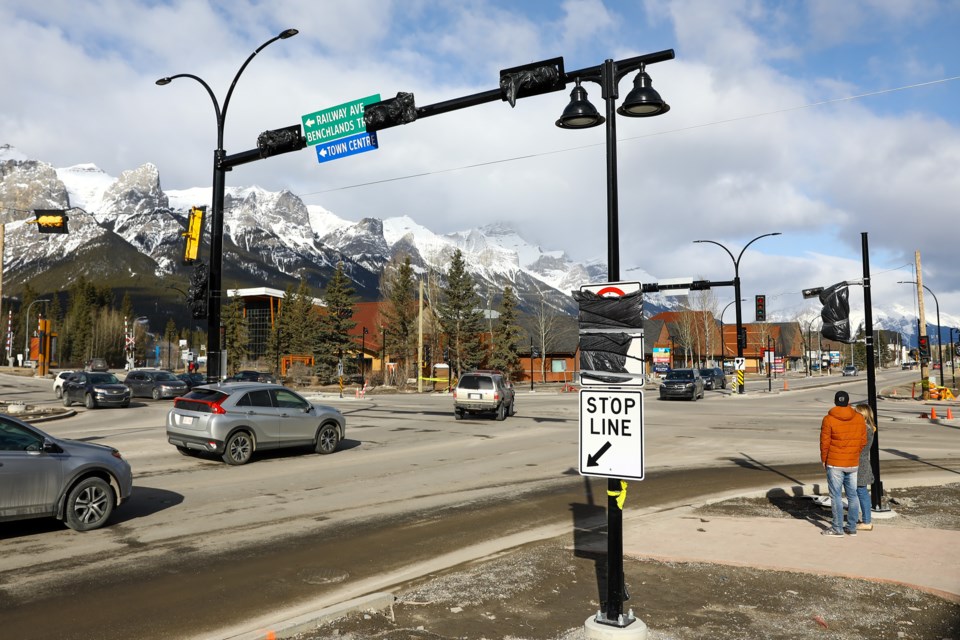CANMORE – Drivers and pedestrians can expect construction to continue this spring at one of the town’s busiest intersections.
The short-term will be a slight pain for motorists aiming to get to their destination, but the long-term benefits will hopefully be reaped for decades to come.
The project – part of the town’s transportation improvement program – will create more connectivity for cyclists and pedestrians. The road work began last year but paused over the winter, and will pick up again this month with an expected completion date of the end of June.
A set of near-side traffic lights – commonly used in Europe – have been installed at the Benchlands Trail and Bow Valley Trail intersection, while the Benchlands Trail overpass will shift from five to four lanes, with one dedicated to pedestrians and cyclists. It will help connect areas to the northeast of the Trans-Canada Highway into the town centre to allow for more connectivity.
“In order to encourage a larger numbers of people to walk and bicycle and accommodate the really large number of people that we have walking and cycling today, you need to give people space to make them feel safe and comfortable,” said Andy Esarte, the town’s manager of engineering. “You need to connect them right from their home all the way to their destination. You can’t have big gaps in the network.”
The municipality's TIP20 plan emphasizes more active modes of transit such as walking and cycling, as well as public transit. It also helps the Town’s commitment to cutting back greenhouse gas emissions.
The idea allows vehicle congestion to ease by giving people more options and access. As the town’s population has expanded and tourism increased, the gridlock has been felt by residents.
Esarte said the town is not only confined by its mountain location, but also the rivers and railways, meaning building more roads is not always possible or productive.
“We're not in the prairies and we can't build an infinite network of roadways, nor would we want to because that would negatively impact the small town feel of being in the mountains. It would take away a lot of the things that we value here in terms of open space and public space.”
A large concern with near-side traffic lights is how cars are able to move, but the change will see each lane get its own movement. For example, rather than turn left or right against oncoming traffic, a driver will have their own turn signal.
It will also give more separation from cyclists and pedestrians from vehicles, enhancing safety.
Esarte said in the short-term, it will add a bit of a delay for drivers. However, it will ease bottlenecks and help the flow of traffic once complete. With more people shifting to different modes of transit, the delays will stay the same rather than growing steadily, as they already were.
“It’s going to take a little bit longer to get around today, but your drive time in 10 years is still going to be the same as it is today as opposed to trying to make it better to drive today, only to watch it progressively get worse over time as vehicular traffic climbs,” he said. “And in our shift to get more walking and cycling, that cannot occur if we continue to build traditional vehicle centric infrastructure.
“This is a tough pill to swallow because nothing gets better right away.”
Esarte said a similar project on Spring Creek Drive has seen a significant jump in people using active modes of transportation since the network is more connected.
“With projects that encourage people to walk and cycle, you pay your cost upfront, but your benefits are going to grow each year. You will only increase the benefit over time as more projects get linked together, and you get a larger share of people walking and cycling.”
Though adding lanes can ease congestion in the short-term, it ultimately pushes the problem down the road, with studies showing the benefit lasts about four years, Esarte said.
For many people used to post-Second World War transportation designs, the intersection may seem backwards. The longstanding idea of adding more roads will ease congestion is true in the short-term, but pushes more reliance on vehicles.
From a municipal standpoint, one of the most costly annual expenses is the repair, maintenance and replacement of roads. The more you build, the more you need to maintain and the more costs run up.
Historically, population centres big and small have been built around the concept of walking mobility. The invention of the car led to vehicles being more emphasized as urban design shifted away from the downtown and public transit to the suburbs.
Esarte said it’s unrealistic to expect every person to trade in their car for a bike, but highlighted by shifting a portion of the population to utilizing a more active mode of transit, it will help traffic flow better throughout the town centre.
Among the changes will see the stop lines adjusted to be pushed back compared to the previous location.
Red concrete will be used for cycling lanes and grey concrete is pedestrian use. Additional symbols and signage will also be posted.
When the project is complete – with an expected end date of June 30 – it will help pedestrian safety and visually improve the area.
“Safety is at the heart of this. We want a safe community and we want a comfortable transportation network. There may be impacts and there may be delays when you choose to drive. Again, those delays are longer than people may have experienced in the past, but they will be significantly shorter than they would otherwise be if we continue to to build strictly for vehicle travel.”



